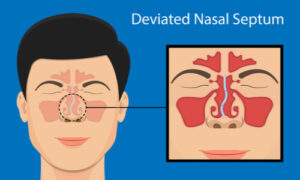More than the added aesthetic, noses have a functional role to play. From smelling foods to supporting your breathing, the nose is more than just any normal body part. Hence, when there are nasal congestion or sinus infections, days become more challenging to pass. While some people occasionally get these nasal problems because of changing seasons or injury, others live through this almost every day. For someone with a deviated septum, nasal congestion is not new. And the difficulty in breathing is a part of their day. Luckily, if you are someone with this problem, there is one efficient remedy. Through professional rhinoplasty surgery, you could be back into your feet and hassle-free nose again. Besides, rhinoplasty surgery is permanent. Hence, it is your one-way ticket to turning your life around. Not sure if you have deviated nasal septum? Worry not. This article will walk you through it.
Nasal Septum In The Normal Context
Noses may look a simple cute bump on the outside, but it has intricate passages and tissue connections inside. One significant internal structure is the nasal septum. This thin cartilage acts as a division wall between the nostrils. And aside from giving your nose a proper lift and structural support, the nasal septum plays a significant role in breathing. It helps in regulating the airflow towards the lungs. Many people are not aware, but despite the cold air you breathe, it gets warm once inside the body flowing to the lungs. And the nasal septum is one key player to this effect. The warm air will pave for efficient and faster exchange of oxygen in the blood.
The Problems With Deviated Nasal Septum
When there is a deviated septum, problems arise. And like a toppled part of the building, it becomes less functional and becomes a 
How Do I Know If I Have A Deviated Nasal Septum?
Unfortunately, even with the high prevalence of deviated septum, only a few notice and feel bothered by the condition. Hence, most do not opt for treatments anymore as it does not affect their way of living. To know if you have one, here are helpful signs and symptoms commonly pointing to a deviated septum:
Nasal Obstruction
With the septum leaning more favorably to one nostril, it will leave the other side too big. And since the other side is smaller, you get to inhale less air. This effect of a deviated septum is more apparent during colds or allergies. In these instances, swelling of the nasal tissues occurs. And will make the narrower side more obstructed than it already is.
Nosebleeds
Since a deviated septum will leave one nostril more prominent than the other, this will also cause more cold air to come in. This result may sound all right, but it is far from it. The cold air will leave the septum more prone to drying. And nosebleeds will start to happen more frequently.
Nasal Congestion

Sinus Infections
Nasal congestion that is not effectively draining could escalate the situation rapidly. Together with the trapped mucus comes stranded bacteria. The longer nasal congestion occurs, the higher possibility for the viruses or bacteria to multiply inside the cavity. This condition will then lead to sinus infections.
Some other symptoms of problematic deviated septum include snoring, face pain, and conscious alternation of the nasal cycle. When symptoms persist, it is best to acquire medical attention immediately.
How Rhinoplasty Helps With Deviated Nasal Septum
Unlike the notion of many, rhinoplasty is not only for cosmetic gains. It could also be functional. One practical application includes correcting the deviated septum. Also known as septoplasty, this surgical treatment primarily focuses on putting or straightening the deviated septum back in place. The surgeon may either remove large or occluding parts of the nasal septum, such as in submucous septal resection. Or straighten the cartilage, like in nasal septum reconstruction. Either way, both techniques will leave the patient with a symmetrical nose and better breathing condition.
How Much Does A Septoplasty In Australia Cost?

Takeaway
Rare occasions of nasal congestion could be ordinary. But when it lasts for a more extended period and occurs more frequently, it is time to see a professional. With the familiar symptoms associated with a deviated septum, only a few patients realize that these indications hide a bigger nasal problem. With the capacity to turn into sinus infections coupled with breathing difficulty, a deviated nasal septum is not something you should ignore. And while decongestants could help ease breathing, their effects would not last for long. Fortunately, with septoplasty, you could have a life-long solution to your problems.
Suspect a deviated nasal septum? Get a private consultation with our top-tier surgeons at (03) 9068 5793.


Recent Comments